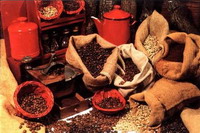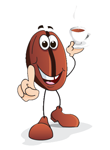|
Did you know that coffee is the second trading commodity in the world, after oil, and leaves behind such worldwide consumed products as meat, coal, sugar and wheat? Its harvest depends on the climatic changes which cannot guarantee equal supply and, thus, permanent consumption every year.
All agreements were under the control of the 'International Coffee Organization (ICO), founded in London in 1962. However they all were terminated because the growers and the consumers were often of too different point of view. So what happens with coffee beans after they are carefully selected and graded? These beans are sold to an exporter who, in his turn, sells them to various importers form the whole globe. The latter distribute these beans among roasters in their countries.
How are coffee beans stored? The green beans are usually stored in 60kg sacks produced from jute, hemp or sisal. These bags are marked with the grade, country and the method of processing. If those bags are kept in ventilated spaces, they could be air-penetrable, not necessarily airtight. The packed beans travel to port warehouses (for waiting for further shipment) either by rail or truck. There are different sources of purchasing green coffee beans. They are called "spot" purchasing, "shipments" or "futures": "Spot"coffee (as it comes from its name) is coffee that has already arrived at the warehouse from the port and is stored there.
Coffee can also be sold through "futures". Futures are contracts bought and sold through the New York Coffee and Sugar Exchange.Futures are mainly used as a guarantee of price protection and real coffee is rarely distributed via such futures. You can find below some links on the coffee export/import statistics published at the ico.org: EXPORTS Exports by exporting countries to all destinations Breakdown of exports of Arabica and Robusta IMPORTS Monthly data - last six months RE-EXPORTS Monthly data - last six months PRODUCTION Total production of exporting countries Source: http://www.ico.org/
|
||||||||||||||||||||||||||
Coffee trade
Coffee trade


 The unstable situation in the coffee world - variable coffee harvest and quality, changing prices - caused by climatic unsteadiness and distinct political interests needs global human control. In order to maintain control and provide stability, all countries involved in coffee business, namely, the growing and purchasing states have established a "Coffee Agreement". However this agreement didn’t succeed in stabilizing coffee production and prices.
The unstable situation in the coffee world - variable coffee harvest and quality, changing prices - caused by climatic unsteadiness and distinct political interests needs global human control. In order to maintain control and provide stability, all countries involved in coffee business, namely, the growing and purchasing states have established a "Coffee Agreement". However this agreement didn’t succeed in stabilizing coffee production and prices. But the roasters don’t buy any kind of coffee. Before purchasing one or another sort of coffee beans they need to perform a cupping procedure. As you all already know, cupping (дать ссылку) is a process of tasting and smelling the beans to verify their quality. At the beginning, certain amount of coffee beans is roasted and ground. After that some coffee is placed in a cup and boiling water poured over. The cupper begins the process of smelling and tasting coffee.
But the roasters don’t buy any kind of coffee. Before purchasing one or another sort of coffee beans they need to perform a cupping procedure. As you all already know, cupping (дать ссылку) is a process of tasting and smelling the beans to verify their quality. At the beginning, certain amount of coffee beans is roasted and ground. After that some coffee is placed in a cup and boiling water poured over. The cupper begins the process of smelling and tasting coffee. Buying coffee that will be shipped at a certain time means you are buying
Buying coffee that will be shipped at a certain time means you are buying 


